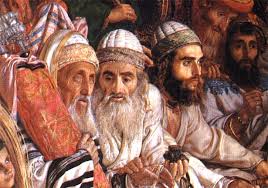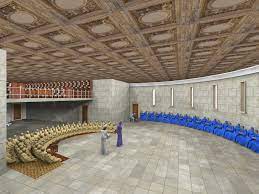The Great Sanhedrin
A group of seventy elders was originally ordained by ADONAI in the wilderness to assist Moshe in leading the nation (see the commentary on Numbers Bt – ADONAI’s Response: Spiritual leadership). A few centuries before the time of Messiah, it had become was the supreme court of Palestine, in addition to being the legislative body. It was comprised of Pharisees, Torah-teachers and Sadducees – the finest minds in Palestine. The people called it the Great Sanhedrin, but the average resident of Tziyon never saw it in deliberation.
There were two types of Sanhedrins, what were known as the Lesser Sanhedrins and, of course, the Great Sanhedrin. The Lesser Sanhedrins, with 23 members, could be found in all the larger Jewish cities and were distinct from the Great Sanhedrin with 71 members. There was a Lesser Sanhedrin in Jerusalem that stood on the Ophel Ridge at the southern entrance to the Temple Mount. In Tosefta II, 6 on the Talmudic tractate Sanhedrin it talks about how Rabbi Gamaliel, together with the elders, used to sit “on the steps of the Temple Mount.” And in the Tractate Sanhedrin 88a, it reads expressly that there was a court of 23 “at the entrance to the Temple Mount.”1507

In the Gospels, the Great Sanhedrin is referred to in different ways: the chief priests, and elders, and all the council (Matthew 26:59 KJV); the chief priests, with the elders, the teachers of the law and the whole Sanhedrin (Mark 15:1 NIV); the chief priests and the Pharisees convened a council (John 11:47 NASB); and was made up of seventy-one [judges] members. The high priest acted like the president (Matthew 26:57; Acts 5:17, 24:1). Sometimes the number of its members was reduced by deaths, but it was in best balance when the court was full. Although the rabbis said their governing body traced back to Moses and his seventy elders (Deut 27:1), the actual seeds of the Great Sanhedrin in the time of Jesus were planted in the time of Ezra and Nehemiah. By the time Christ was born the Great Sanhedrin acted as the Jewish supreme court, taking appeals from cases decided by Lesser Sanhedrins (Mark 14:55).
Politically the Sanhedrin maintained a balance between the Sadducees, believers in the five books of Moses, and the Pharisees, believers in the Oral Law (to see link click Ei – The Oral Law). As the supporters of the Oral Law, the Pharisees were louder and more voluble and their public behavior was seen as more holy than that of the Sadducees. Judaism was doomed, they shouted, unless the Oral Law became the law for all of Judah. The Pharisees actually elevated it a little higher than the written Law. The rabbis taught, “He who studies the Torah does a good thing; but he who studies the Oral Law does an even better thing.”
In spite of the political balance, the Pharisees were in some respects the strong men of the Sanhedrin when Caiaphas was high priest. He was a Sadducee, and he drew his power from another Sadducee, Annas. But the voices most often heard in the high court were doubtless the Pharisees, whose perpetual attitude was one of outraged piety. They had no more votes than the Sadducees – perhaps a few less because a Sadducee from the tribe of Levi was always the high priest – but the Pharisees had the ears of the people with their predictions of doom and punishment. Membership was for life. Some, in old age, withdrew to retirement. However, almost all died in office. So far as we know, only two classes of men were theoretically excluded from membership: bastards and converts to Judaism.1508
Their meetings were irregular, depending upon the amount of business that required the attention of the court. From 30 AD on the Great Sanhedrin met in a room, with its half-moon seating arrangement, on the east end of the Royal Stoa.

Previously, its meetings had taken place in the Hall of Polished Stones on the southwest side of the Temple. The Talmud reports the Sanhedrin moved into the [Royal Stoa] some forty years before the destruction of the Temple in 70 AD. On the night of Jesus’ trial, however, they met first in the [palace] of Caiaphas the high priest (Luke 22:54a).1509
From the beginning of the Maccabean Revolt (167 BC), the power of the high priest increased (First Maccabees 12:6). However, Herod the Great weakened the Great Sanhedrin considerably, and on his deathbed he ordered that some members of the Sanhedrin be killed on the day he died to ensure that tears would be shed at his passing. But the Roman procurators (AD 6-41), who had mastered the art of ruling subjected people, enhanced the prestige of the Great Sanhedrin and gave it greater power (Josephus Antiquities 20.200.251). They permitted the Sanhedrin to have supreme authority in religious matters and a fair amount of power in civil affairs.
The Great Sanhedrin was permitted by Rome to make and enforce laws that had to do with Palestine’s internal affairs; in external affairs Caesar made the rules. The Sanhedrin could, in local jurisprudence, pass the death sentence on Jews, or even on Gentiles who were not citizens of Rome, but such a sentence had to be reviewed by the Roman Procurator and confirmed. To assure her ultimate control of the Jews in Palestine, the Romans would periodically replace the high priest at their pleasure. The Jews however, still viewed the hereditary descendant of Aaron as the only legitimate high priest no matter what the Romans said. In the Gospels, the Romans had appointed Caiaphas, but the Jews viewed his father-in-law Annas as the legitimate high priest and the real power behind the scenes.1510
At least in theory, the Great Sanhedrin’s sphere of authority extended over the spiritual, political and legal affairs of all Jews. If the members of a local court disagreed on a point of the Torah, the matter was referred to the Jerusalem court that sat at the gate of the Temple Mount. If the dispute could not be resolved, it went to the court that sat at the gate of the Temple Court. If a resolution was still not found, the Sanhedrin heard the dispute. Thereafter, on pain of death, local judges were to follow the ruling.1511
Many of the rules governing the Sanhedrin in sessions were not put in writing until centuries later, but it is probably fair to say that the court sat in a semicircle so that the members could look upon one another. They sat in three graduated rows, with the high priest in the center and older members flanking him according to seniority.
Two clerks sat in front, facing the court. One was stationed on the left; one on the right. In criminal cases, when all the testimony was in, the clerks called the names of the members starting with the youngest members so that, if they differed with the elders, they would not be embarrassed. One of the clerks collected all the votes for acquittal; the other tallied all those who favored conviction. The Great Sanhedrin could sit in judgment with as few as twenty-three members present.1512
The court sat from the morning sacrifice at 9 am until the afternoon sacrifice at 3 pm. The rabbis teach that the lamb was slaughtered at 2:30 pm and its pieces laid on the bronze altar at 3:00 pm.1513 Most trials were noisy and confrontational. The judges sat on their crescent benches, and across the chamber, the plaintiffs and defendants sat on their benches. As each piece of evidence was presented, the Sanhedrin fell on it and argued pro and con across the benches. All sentences in criminal cases were severe. There were no prisons or no asylums. Banishment was a minor sentence. The Sanhedrin had its own rules (see Lh – The Laws of the Great Sanhedrin Regarding Trials). The most important of these, so far as Jesus was concerned, was “a tribe, a false prophet or a high priest are not judged unless all seventy-one are present.” If the Savior were to be arrested and tried, it would have to be as a false prophet.
Each death sentence was passed on, before execution, to the Roman procurator. He usually affirmed it without question. If he felt so disposed, or if someone had pleaded the case with him privately, the procurator might summon the accused and accusers and hear the case before his own judicial chair. But, if he reversed the verdict, the condemned was acquitted and the Great Sanhedrin was powerless. If he confirmed it, the governor often forced the prisoner to undergo the Roman form of execution: crucifixion.1514



Leave A Comment